Expertise Areas
Abstract:
Material choice is critical for ensuring sustainability in the construction industry. Higher carbon embodiment materials contribute towards greenhouse gas emissions and global warming. Decisions on sustainable material selection depend on multiple criteria and variables, thus creating a difficulty to determine the best choice. Multi-Criteria Decision Making (MCDM) techniques have the potential to address this challenge. However, there is limited data that reviews MCDM in choosing building and construction materials.
This study aims to review the MCDM methods employed in the sustainable selection of building materials within the construction industry. This systematic literature review (SLR) incorporates meta-analysis and thematic mapping through applying “PRISMA framework” and “Bibliometrix”, respectively. This study explored and analysed the records published from 2010 to 2023. This work identified the critical steps for addressing decision problems in building material selection: Establishing criteria, ranking the hierarchy, comparing the selection criteria, and enabling consistency indices.
Moreover, one of the most used MCDM methods, i.e. Analytical Hierarchy Process (AHP) was particularly found particularly useful for the selection criteria and weight assignment of variables regarding the waste, recycled, and composite materials. The involvement of several criteria and alternatives raised the complexity of decision problems, leading to the use of Hybrid MCDM. Hybrid MCDM techniques possess the capacity guide informed decisions for the sustainable material selection in the construction industry.
1. Introduction:
The pace of urbanisation to accommodate the growing population has sped up the expansion of construction industry. On top of that the resource intensiveness of construction sector accounts it for higher quantities of cement utilisation and increased human activities (Jie et al. 2023) exerting a toll on environment in the form of increasing levels of anthropogenic emissions, construction demolition and waste. Recent research has revealed that selecting sustainable materials can prove crucial for capacity building and laying and consolidating groundwork for decisions and actions to achieve net zero carbon goals.
Researchers have also highlighted the need for transitioning towards sustainable construction practises (Boobalan et al. 2022). Several studies have reiterated the need to select sustainable construction materials as a crucial step towards sustainable construction (Syed Naseer et al. 2023). The process of choosing a sustainable material for the construction field entails significant effort (Jahan et al. 2010). The struggle can become even more challenging while making informed decisions and guided actions for supporting sustainable construction. A stakeholder in the construction industry may succumb to a disadvantage owing to the unsuitable selection of materials (Jahan et al. 2011).
Traditionally, construction materials are selected based on technical and economic considerations hardly giving much importance to the environmental aspects (Alam Bhuiyan and Hammad, 2023). On top of that merely relying on the material datasheets or directories is not sufficient because of ever-growing construction industry. However, conventional material datasheets and directories are not sufficient for enabling such a sustainable design which do not adversely impact the environment and the habitats (Shaharuzaman et al. 2021a). The scope of using traditional methods and systems for choosing materials is relatively narrow compared with the newly emerging intelligent knowledge-based systems, and one of these is multi-criteria decision making (MCDM) for material selection (Oliveira et al. 2019).
However, there have been few research publications that have methodically reviewed MCDM in the field of construction. One of the reasons is, the criteria for the selection of materials modestly differs industry-wise, for example, aerospace industry includes financial, safety, structural, manufacturing, and environmental impact, whereas the bicycle industry includes factors like weight and shape of the sections (Ul Haq et al. 2022, Syed Naseer et al. 2023). When it comes to construction industry, the focus of material selection is on strength properties, availability (of materials), sustainability, discoverability and design aesthetics and resourcefulness (Al-Radhi et al. 2023).
The other challenging aspect is the degree of flexibility MCDM applications as the material requirements also vary for a number of industries except for the point when it comes to selection of sustainable materials (Tajik et al. 2023). Oliveira et al. (2019) have presented barriers towards the adoption and implementation of MCDM. The MCDM approaches support the informed decisions in selecting the construction materials and to that end it is important to identify the materials used in the construction industry and also these methods take not only technoeconomic and environmental but also cultural and social factors into account (Mathiyazhagan et al. 2019).
Most commonly used construction materials are: (1) Timber, (2) Steel, (3) Concrete, and (4) Composite materials (Al-Radhi et al. 2023) and literature is available on benchmarking the performance of these materials through MCDM in the industries other than construction industry, however there is noticeable gap on seeking relevance of MCDM for new materials in construction industry.
MCDM approaches would help material scientists, architects, engineers, and construction manager to accelerate sustainability through material choice across a wide range of MCDM available. This study attempts to meet the requirements and hopes of the construction industry stakeholders particularly material engineers, quantity surveyors and sustainability scientists to be mindful, acknowledge and integrate MCDM for seamless material selection process. The study provides a thorough assessment of existing state of disruptive methods across various industries, their benefits, opportunities, and barriers. The study also focuses the foundational techniques for MCDM. This study is carefully crafted a systematic approach to offer a detailed review and actionable recommendations about the tested and successfully applied MCDM methods of key significance.
Thus, this paper directs its attention to the research objectives: To review the existing body of knowledge on multi-criteria decision-making methods and identify future research opportunities and limitations of MCDM.
2. Literature Review:
Sustainable construction is a mean to mitigate the negative impact of climate through creating low carbon building envelops (Chandrakumar et al. 2020). The definition of term sustainable construction is not that simple (Du Plessis, 2007), however Kiebert (1994) remarks sustainable construction means to create and responsibly manage healthy built environment on the basis of resource efficient and ecological principles. Sustainable construction in relation with material selection context means cutting down quantities of materials used in construction beginning from the extraction and processing to consumption as well as implying the less use of energy and producing less waste (Boyle, 2005). Moreover, Dutil et al. (2011) also argues on using the materials with low embodied energy as a crucial component for achieving sustainability. Main objectives of a sustainable design through materials selection approach are to ensure resource efficiency, support environmental conservation, and improve cost effectiveness (Samudrala et al. 2023; Oztemel and Gursev 2020; Monteiro et al. 2017), Fig. 1 illustrates a pictorial glimpse of the advantages that sustainable material practise offers. Material selection is one of the most crucial steps in achieving sustainable construction. Adopting sustainable material selection approaches can significantly lower the demand of virgin materials and produce less waste and carbon footprint (Cramer, 2023).
Fig. 1
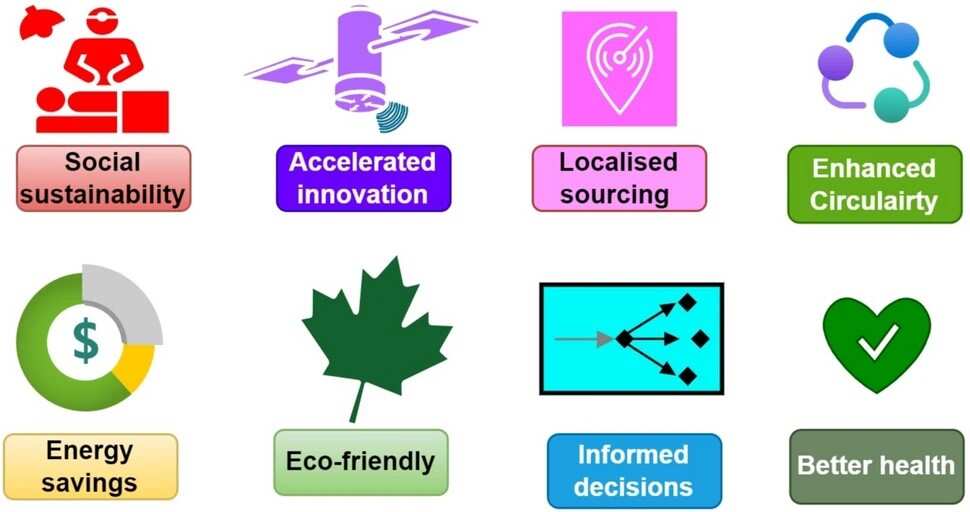
Sustainable material selection is an imperative in the building design as it influences important decisions regarding a construction project’s environmental impact, cost, and quality (Shaharuzaman et al. 2021b). Studies have supported using multi-criteria decision-making techniques can lead to more effective material selection (Jahan et al. 2010). Another study has demonstrated the significance of multi-criteria decision methods in the ever-growing construction industry (Govindan et al. 2016). Multi-criteria Decision Making (MCDM) method implies a systematic approach to determine the best feasible solution according to an established criteria and problems that occur in real life (Jahan et al. 2016). The principals and applications of MCDM are represented as a mean to facilitate early conceptual design and product development process (Shaharuzaman et al. 2021a). The same study reveals that modern MCDM approach employs systematic and collective methods using advanced tools. MCDM approaches has been applied in different industries over the time to analyse, rank, and select the best materials tailored to their desired purpose and pursuit. MCDM approaches has been applied in different industries over the time to analyse, rank, and select the best materials tailored to their desired purpose and pursuit (Awate and Barve 2021). Furthermore, Yang et al. (2022) categorised sixteen (16) MCDM methods for material selection across a wide range of industries.
Initially, the application of multi-criteria decision analysis in the realm of environmental conservation was done by Kiker et al. (2005), who proposed a general analytical framework for complex environmental problems but so far the scarcity of research publications on MCDM for material selection in construction projects has been a challenge (Lazar and Chithra 2020).
Fig. 2
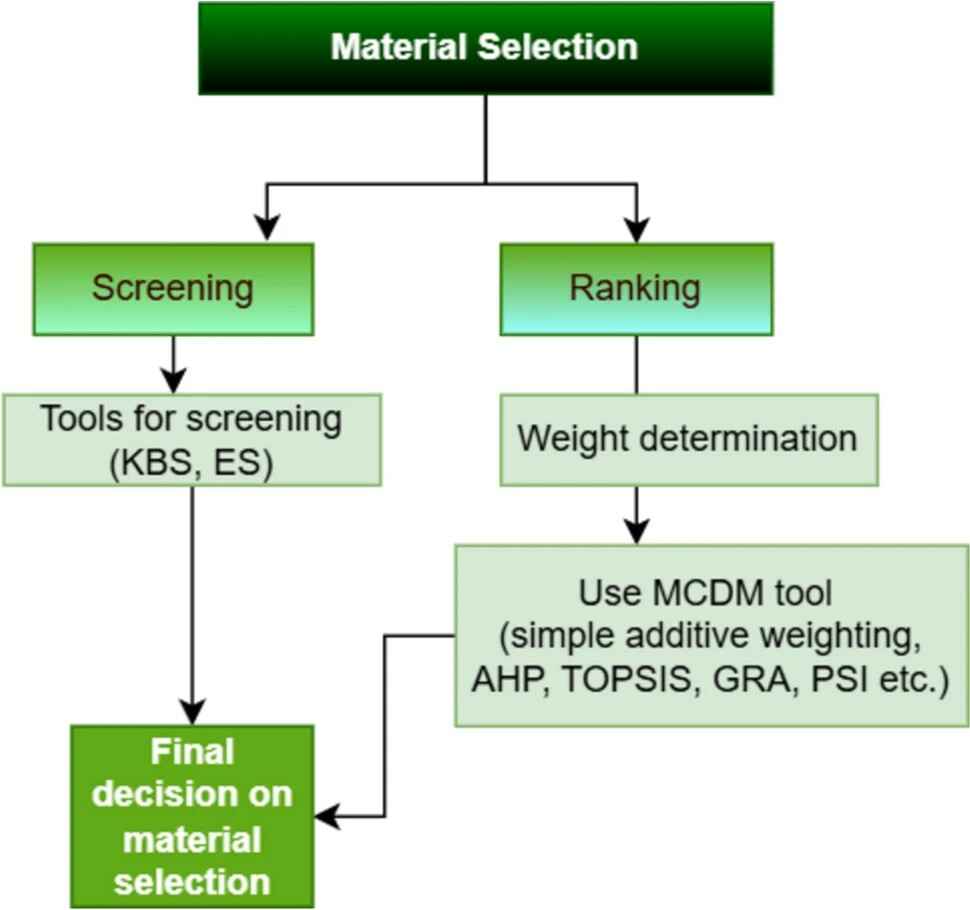
Material selection process has been categorised into two important steps (Fig. 2) (i) Screening (ii) Ranking; the former requires screening techniques, knowledge-based systems (KBS) and expert systems while weight determination and hierarchical position are the important components of the later method (Shaharuzaman et al. 2021a). The selection of the suitable materials is a complex issue as it requires multiple features of validation and precision (Alaaeddin et al. 2019).
However, despite gaining a ground in the research arenas the MCDM approaches face several challenges in terms of adoption. Extensive literature studies have shown management of larger datasets (Noryani et al. 2019), absence of realisation regarding advantages (Marttunen et al. 2017), level of methodical quality (Oliveira et al. 2019), effective utilisation of expert input (Estévez et al. 2021), and measuring the long-term consequences (Montibeller and Franco 2011) of MCDM to be the key barriers. The study has also identified the challenges and addressed the challenges by providing a roadmap for effective implementation of the highlighted MCDM approaches.
3. Research Methodology:
Motivated by the competencies and prospects of the MCDM, this research is concentrating on the standalone as well as hybrid MCDM approaches for material selection. This attempt strives to offer a holistic understanding about the formation and execution of MCDM oriented towards sustainability.
A roadmap for implementing the appropriate techniques is one of the key outcomes of this effort. To achieve this goal, the research team conducted a systematic literature review (SLR) consisting of meta-analysis and thematic mapping through following the “PRISMA framework” and “Bibliometric”, respectively
(Figs. 3, 4). Bibliometrix is an R-package, to exhaustively examine the existing state of knowledge on MCDM inclusive of trends and thematic explorations Qualitative research approach is used to identify the essential components of each method contributing towards an effective and robust material selection processes.
Fig. 3

Fig. 4
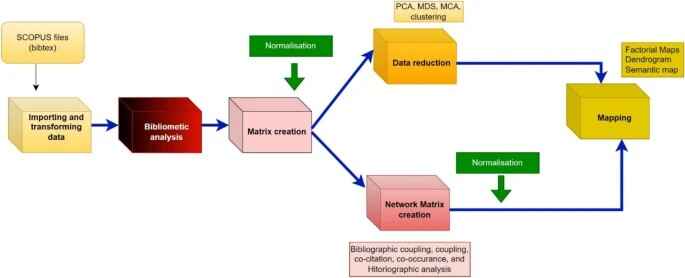
3.1 Systematic literature review
This study employed systematic literature review of the published records through PRISMA framework. This approach (PRISMA) focuses on the general guidelines to conduct a review recommended by the studies (Pati and Lorusso 2018; Khan et al. 2003). Figure 5 provides the breakdown of the steps taken to conduct the SLR for this study.
Fig. 5
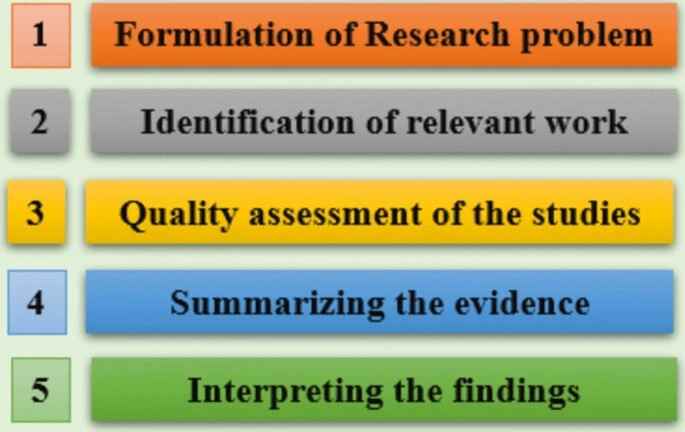
3.1.1 Formulation of research problem
Ratan et al. (2019) expounded the important facets of the research questions, such as, (a) Detailing the problem statement, (b) Refining the issue under study, (c) Adding focus to the stated problem, (d) Guiding collection of data and analysis, and (e) Developing the scope of research. Furthermore, description and classification-format based research questions are, (1) What are the different categories of MCDM methods available in published literature on construction? (2) How MCDM approach is applied to tackle the decision problems of material selection?
3.1.2 Identification of relevant work:
The closely relevant publication records were explored by choosing the SCOPUS database. Peer-reviewed literature database, excellent navigation, and reliable, rapid, and relevant availability are the reasons behind choosing SCOPUS (Burnham, 2006). Combining the keywords after going through extensive literature study on MCDM for material selection, this research attempt began. The combination of keyword string was placed in the “Search within” option of SCOPUS. At first the field code (All “material selection” AND “multi-criteria decision making” OR mcdm AND “construction”) is applied to assess the frequency of the records.
The second stage begins by applying the field code (Title-Abstract-Keyword “material selection” AND “multi-criteria decision making” OR mcdm AND “construction”) is total of 35 SCOPUS records are selected through the predefined exclusion criteria set by this study, whereas an additional 25 number of publications are added through Google Scholar’s author citation network. This whole scheme for including and excluding the relevant records is available in the form of PRISMA mapping following the guidelines Sarkis-Onofre et al. (2021) has charted out.
3.1.3 Quality Assessment of the Studies:
The quality evaluation of the publication records yielded through PRISMA framework is the 3rd step of this SLR. Kelly et al. (2001) suggested that the SLRs need to pay attention to explicate the exclusion and inclusion criteria with utmost clarity. Focusing on the recommendations of (Kelly et al. 2001; Oxman and Guyatt 1988), the study included records from Scopus database which is a peer reviewed search engine. Moreover, Mallen et al. (2006) clarify in their study on “Quality assessment of observational studies…” that there is no consensus in the method for quality evaluation, however, they provide 30 different criteria for the quality checks to examine the records. It is necessary to avoid any misleading and inaccurate information in the research Practise, (it can be seen in Fig. 6, where this work judged the published records based on the four quality checks, reducing the selected research records to 23).
Fig. 6
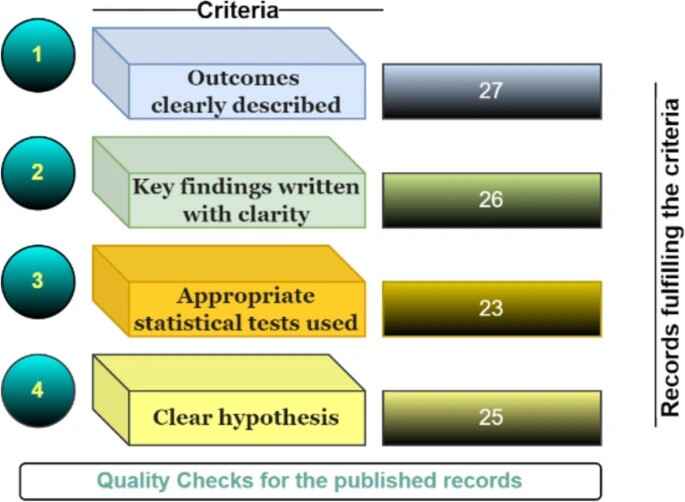
3.1.4 Summarising the evidence
The study conducted a detailed analysis of the included records and interpreted the findings to recognise different MCDM approaches. Study has identified following broader trends after the in-depth analysis of the publication records.
The initial analysis of the records revealed that the MCDM approaches are divided into two distinct branches from application point of view in construction: (1) Standalone MCDM and (2) Hybrid or Integrated MCDM (The details and applications of both approaches are briefly discussed in the “Findings” section).
3.2 Method for Bibliometric Analysis:
The current investigation adopted bibliometric analysis to understand the intellectual structure and grasp the boundary of accumulated knowledge on Multi-criteria decision-making (MCDM) approaches. The significant advantage of performing the bibliometric analysis is its potential to introduce a “…systematic, transparent, and reproducible review process…” as Aria and Cuccurullo (2017) reported based on scrutiny of multiple research records. “Bibliometrix” is the specific, user-friendly, and open source “R package” for synthesising a comprehensive scientific mapping of published records. This tool also offers an interactive workflow with multiple mapping options. Figure 4 displays a pictorial scheme of the tool starting from importing a “Bibtex” from a chosen database (SCOPUS) into the workflow of Bibliometrix.
The dataset (in Bibtex) contains essential information about citations, bibliography, abstract and keywords, and miscellaneous data. The next step is loading and conversion of the data under consideration. The third and fourth stages capitalising one of the options available on Bibliometrix: (1) Clusters and conceptual maps, (2) Network mapping, (3) Keyword co-occurrence map, and (4) Wordcloud based on the guidelines (Aria and Cuccurullo 2017).
4. Findings:
The structure of this section is such that we briefly express the outcomes of bibliometric analysis followed by the systematic literature review. One of the study’s objectives was to discuss the current state of knowledge on MCDM for selecting materials in the construction industry. The findings section of this work represents the evidence-based analysis of the published records. The bibliometric analysis helped paint the visual canvass of the research; on the other hand, systematic analysis of the literature particularly stood out in delineating the trends, relationships, applications, and advancements in the MCDM, specifically in the material selection process.
4.1 Bibliometric analysis—results:
This section depicts the visual picture of critical themes and prominent concepts within the chosen research literature. There has been an increasing trend of published research records on the application of MCDM in the construction industry (Fig. 7). Moreover, the top four countries publishing more articles on MCDM are India, Malaysia, Iran, and Turkey (Fig. 8).
Fig. 7
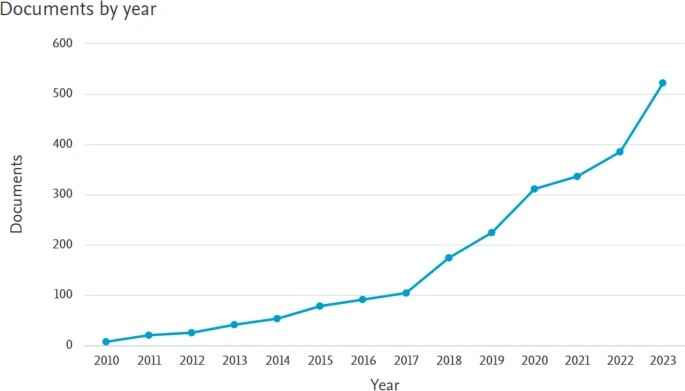
Fig. 8


Word frequency analysis displayed the most/least common keywords. “Decision making” ranks as the most frequently used keyword, followed by construction and industry, which are the second and third most frequently occurring words, respectively (Fig. 10). The first four most used keywords also form a pattern: “decision making…” in “construction industry…” through “material selection” for “sustainable development”. It signifies the cruciality of material selection as a potential decision-making problem that can support actions and guidelines towards sustainable development. Multi-criteria decision-making is also one of the most prominent keywords; it could have Top of the chart keyword. The difference happened because different authors preferred to use distinct syntax for the keywords with, for example, hyphenated ‘-’ symbols in different placements of keywords, e.g. (“multi-criteria decision-making”), (“multi-criteria decision-making”), and (“multi criterion decision making”).
Fig. 10

Finally, the research team provided the keyword analysis of the research documents across three domains: abstract, author keywords, and titles. Bibliometrix has a Keyword Plus feature which provides most frequent keywords. Most frequent words using keyword plus feature are Decision making, construction industry, material selection, and sustainable development (Fig. 11a). This study also capitalised on unigram, bigram, and trigram keyword analysis, a derivative feature of Keyword Plus that only classifies the keywords across the abstract of the records under consideration. Unigrams (Fig. 11b), bigrams (Fig. 11c), and trigrams (Fig. 11d) are the one, two, and three word-units of a keyword phrase across the abstract, respectively.
Fig. 11
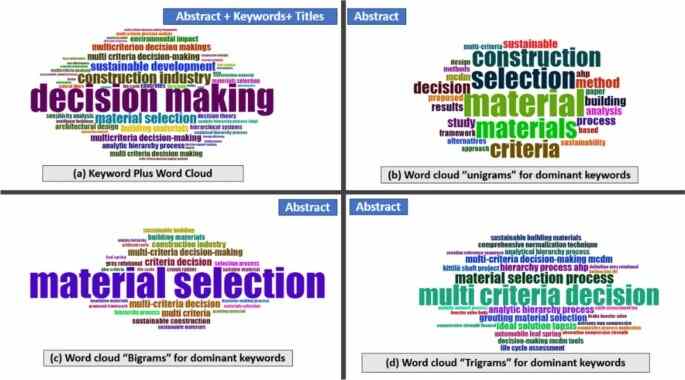
The co-occurrence network is a semantic map constructed using Bibliometrix. This network provided keywords extracted from selected studies. The network consists of nodes, the individual words (in the title, abstract, and indexed keyword), and knots between these nodes express the frequency with which the words co-occur (Fig. 12).
Fig. 12

The “Co-occurrence degree plot” feature of Bibliometrix exhibits a graphical distribution of connection strength (Fig. 13). “Decision making” with a degree value of “1” represents the reference value of this topic to be maximum at rate 1. The degree distribution of all other nodes (i.e. Construction industry degree value with 0.475) is calculated as a fraction of the reference value. Thus, the lower value cumulative degree represents weaker connectivity of a topic with other co-occurring topics. The top nodes exhibited the higher cumulative degree in the network because topics like “Decision making”, “construction industry”, “material selection”, and “sustainable development” hold key considerations while tackling decision problems of material selection. The analytical hierarchy process (AHP) is also one of the most connected nodes in this field; it is one of the MCDM methods (Fig. 13).
Fig. 13

Figure 14 provides the visual map of the major research themes found in selected studies. Niche themes hold minor relevance to the research area but have connections to other low-relevance topics. Motor themes signal (Analytical hierarchy process, multi-criteria decision making, construction materials) highly significant and well researched decision methods explored in studies. Emerging or declining themes express that the topics are in earlier development and their relevance has not been tested significantly in research (Table 1).

Table 1 Use of different MCDM in material Selection
From: Material selection in the construction industry: a systematic literature review on multi-criteria decision making
4.2 Interpretation of the in-depth analysis
This review attempted to explore the role of MCDM methods. The study detailed the information about the most critical steps in solving the materials-related decision problems through MCDM, most used MCDM approaches, a descriptive analysis of the existing problems, influence factors and limitations and future of MCDM approaches. A summary of the relevant evidence with respect to sources, year of publication, MCDM method (hybrid or standalone), construction material type, and research findings have been tabled. The extracted findings focused on the identified methodological approach, criteria evaluation, and research gaps in a succinct tabular form (Table 2).
4.2.1 Deconstructing the multi-criteria decision problem
A growing body of research agrees that the critical aspects of any MCDM method across the disciplines have following key steps (Govindan et al. 2016, Alam Bhuiyan and Hammad, 2023, Tajik et al. 2023, Tian et al. 2018).
(1) Define the scope and goal,
(2) Establish the criteria,
(3) Mark its sub-criteria,
(4) Calculate the weight of the criteria, and.
(5) Examine the alternatives.
MCDM methods have been applied to choose diverse range of materials, i.e. composites (agri-waste, recycling, rubber, and fibre based). Moreover, a wider scope of the applicability of the MCDM is discovered by this study as the multi-criteria decision making is useful for the customised, reliable, and optimum selection of external walls, roofs, insulations, and aesthetic amelioration. Figure 15 displays the list of four most used MCDM methods AHP, TOPSIS, COPRAS-G, and VIKOR and the critical stages to address decision problems.
Fig. 15

For example, Alam Bhuiyan and Hammad (2023) indicated the goal of their study as to selecting most sustainable structural material, followed by the classification of technical, economic, social, and environmental criteria. Durability (life expectancy) and maintainability, material cost and end of life cost, compatibility and skilled labour availability, and greenhouse gas emissions and recycling potential were among the 16 technical, economic, social, and environmental sub-criteria, respectively. They formulated the decision problem by comparing the alternatives such as reinforced concrete, structural steel, timber, and reinforced masonry (Table 2).
4.2.2 Material selection in construction through MCDM
4.2.2.1 Rationale for choosing the MCDM
The results of the selected articles reported that multifaceted nature of material selection problems draw the need for using an MCDM (Kumar Chilukuri et al. 2023). For the identification of the most optimal alternative TOPSIS, EDAS, WPM are the preferred MCDM methods. TOPSIS is particularly effective in addressing physical, mechanical, and mix composition properties of the composite construction materials (Soni et al. 2023). However, some studies reported the utilisation of AHP for similar case scenario, where exploring alternative grouting materials was the problem under study (Lehtonen 2019). Table 1 displays the key strength of the methods used for material selection applications.
4.2.2.2 Standalone MCDM
This study has highlighted several material selection problems addressed by standalone or a single MCDM method. Analytical hierarchy process (AHP) stands out as the mostly utilised standalone MCDM approach. Waris et al. (2019) argues the wider and successful applicability of AHP in multiple disciplines. However, a study has described the limitation of AHP in contrast with Choosing by Advantage (CBA) method, reasoning that AHP does incorporate the conflicting verdicts (Arroyo et al. 2015). Figure 16 reveals the materials selected for different construction applications based by using MCDM. Analysis of the articles, this study has found that most studies have used one the three so-called pillars of sustainability, namely economic, environmental, and social sustainability. These sustainability indicators have been further subdivided into subcategories shown in Fig. 16. Studies have not expressed the rationale behind using a particular standalone MCDM method, however, AHP was one of the most used standalone methods with applications in the selection of composite and insulation materials.
Fig. 16
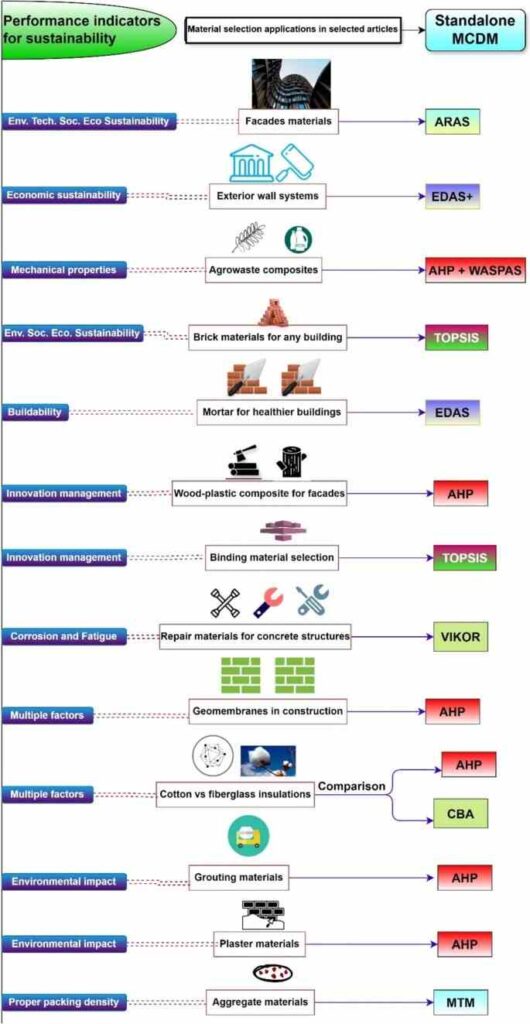
4.2.2.3 Hybrid or integrated MCDM
An MCDM approach is hybrid or integrated when a decision problem is addressed by combination of two or more than two methods. Technique for Order of Preference by Similarity to Ideal Solution (TOPSIS) with its comprehensiveness and robustness is the most connected method (Iqbal et al. 2021; Awate and Barve 2021; Reddy et al. 2022; Phong et al. 2017). The key applications of hybrid or integrated MCDM approaches are shown in Fig. 17. The hybrid approaches are useful for addressing broad indicators of sustainability.
Fig. 17

4.2.3 Factors of influence
Most studies have addressed the three pillars of sustainability as factors of common interest while applying MCDM methods in the sustainable selection of materials (Fig. 18). Studies by Tian et al. (2018), (Mathiyazhagan et al. 2019; Beltrán and Martínez-Gómez 2019) indicate that sustainability (environmental, economic, and social) is a crucial factor in selecting the materials. However, the analysis of the included records revealed that technical factors also influence the decision problems of material selection (Yoris-Nobile et al. 2023; Kiani et al. 2018; Kumar Chilukuri et al. 2023). A decision support system (DSS) combining three methods AHP, VIKOR, and TOPSIS helped out select the timber materials (Alam Bhuiyan and Hammad, 2023). The same study notably defined the three pillars of sustainability as economic, social, and environmental sustainability. Kiani et al. (2018) sought the usefulness of the VIKOR method for best suited repair materials, however they also mentioned the significance of assigned weights to affect the reliability of results.
Fig. 18
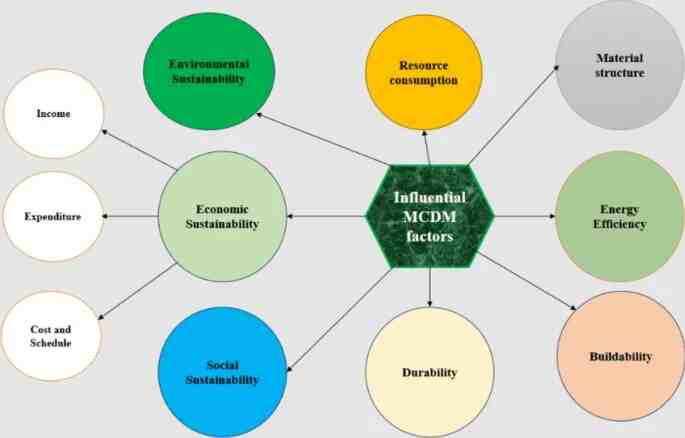
The future efforts can address the conflicting parameters and assigned weights through comparing more than one MCDM methods for reliable results. Packing density of concrete materials affected the performance of the concrete materials and Modified Toufar Model (MTM) supported the decision mechanism for choosing the appropriate source for optimal aggregate size and packing density in required proportions (Shah et al. 2020). It is interesting to note that most of the research work analysed in this study capitalised on multi-criteria decision systems to ensure the sustainability as a major goal in all the material selection decision problems (Di Ruocco et al. 2022, Zavadskas et al. 2018, Alam Bhuiyan and Hammad, 2023, Estévez et al. 2021, Mathiyazhagan et al. 2019, Khoshnava et al. 2018, Markatos and Pantelakis 2022, Hatefi et al. 2021, Taylor et al. 2023).
4.3 Limitations of MCDM
Lam et al. (2023) recognised that the effectiveness and flexibility of MCDM for material selection problems are crucial. Uncertainties arise when the factors are interdependent, and judgment about selection becomes complex (Arroyo et al. 2015). There are limited number of research records on the validation of the MCDM has not been performed and the MCDM applications has been more reliant on the opinions of a few experts (Aksakal et al. 2022). The feasibility studies are also limited on the decision making methods, its role is vital ensuring the effectiveness of these methods (Hatefi et al. 2021).
4.4 Future of MCDM
Studies have hinted at the inclusion of automation of MCDM methods. For example, an AI-based AHP will likely be fast-paced and informed for sustainable selecting material. A study has hinted connecting MCDM with Life Cycle Assessment (LCA) parameters to address the challenge of sustainability during material selection decisions (Churi and Biswas 2019). However, majority of the research articles using MCDM did not consider life cycle assessment (LCA) tools. This is a noticeable research gap explored in the chosen studies and require further research efforts in future. The consensus on the interpretation of sustainable construction may vary from one organisation to another, primarily when the opinions are based on individual respondents’ expertise, so statistical tools are suggested to validate the results (Govindan et al. 2016). It is possible to create a support mechanism for helping the material selection scientists through integrated MCDM (Soni et al. 2023). There is abundant room to expand the applications of MCDM for green actions in construction (Khoshnava et al. 2018). Further research with more focus on the transparency of the MCDM could also be a focus of interest in future. Moreover, solutions devised through MCDM can be adapted at a broader scale for similar decision problems arising in other parts of the world, thus creating and consolidating the effectiveness of these methods in fragmented domains of the construction industry (Beltrán and Martínez-Gómez 2019).
4.4.1 MCDM and LCA integration for sustainable material selection
Life Cycle Assessment (LCA) and Multi-Criteria Decision Making (MCDM) integration is a powerful way of evaluating complex sustainability issues. The structured framework offered by MCDM is essential to handle both quantitative and qualitative criteria at the same time needed for interpreting LCA results (Fig. 19). The combination provides decision-making processes that take into account an integrated manner environmental, economic, and social dimensions.

By integrating MCDM with LCA, the holistic evaluation of building designs is possible, as applied to residential projects with ecological performance as a priority (Vollmer et al. 2024). Interpreting LCA results requires a consistent structure for decision making, which is possible through the application of MCDM. It supports environmental and sustainability assessments by helping to evaluate alternatives considering different criteria (Angelo, 2021).
The combination of LCA and MCDM produces a comprehensive evaluation of products and services at the same time considering environmental, economic, and social aspects. This is important in life cycle sustainability assessment (LCSA) as it helps to fit for a more comprehensive environmental sustainability evaluation (Dias et al. 2019). Fuzzy MCDM methods including fuzzy TOPSIS are used to provide better reliability for the assessments by incorporating time-based satisfaction and risk factors. This is especially appropriate to high-investment, long life cycle projects (Shao et al. 2024). The selection and assessment of criteria are one of the major challenges in coupling MCDM with LCA and can influence significantly the assessments (Dias et al. 2019).
5. Conclusion:
This study presents a methodology for addressing the decision problem of material selection through MCDM. This approach utilised the PRISMA framework and Bibliometrix for Meta-analysis and thematic analysis. We showcased a combination of MCDM methods, relative specifications, frequency of utilisation, applications to multiple categories of materials, limitations, and direction for future work. The core objective of the MCDM problems appeared to be sustainability in several research studies. Our literature review approach uniquely considers evaluating MCDM methods like AHP, VIKOR, TOPSIS, COPRAS-G, MTM, BWM, and CBA as standalone and integrated to rank the alternatives. This review defined multi-criteria approaches to solve the conflicts among thresholds provided by different prediction models and certain constraints described by different regulations in different and diverse settings.
The limitation of this study is that it does not cover the specific segments of the construction industry for meta-analysis; for example, it views MCDM approaches for general construction industry applications towards decision problems on material selection but does not focus on meta-analysis of other categories like 3D printing, modular construction, and prefab construction. Another limitation of this study is that it needs to include the feedback of the industry stakeholders to draw a holistic picture of MCDM.
In summary, the systematic literature review probed into the competencies and potentials of Multi-criteria Decision-Making (MCDM) for sustainable material selection across diverse construction categories. The findings from 23 meticulously chosen studies and their corresponding MCDM methods reveal a cause-and-effect relationship between methodological choices and material selection outcomes. From exploring environmental assessment variables to ranking materials against comfort parameters, the research showcases the versatility of MCDM. Methodological nuances, including the integration of objective and subjective weights, the development of innovative approaches, and the emphasis on regional specificity, underscore the intricate role of MCDM in shaping decisions, and delivered in a simple manner to address the concerns of multiple construction industry stakeholders. This review will equip the building scientists, material engineers, sustainability experts, and policy makers with the essential knowledge of the standalone and hybrid MCDM methods.
Data Availability:
No datasets were generated or analysed during the current study.
Abbreviations:
- AHP:
-
Analytical hierarchy process
- ANP:
-
Analytic network process
- AR:
-
Artificial reef
- ARAS:
-
Additive ratio assessment
- CODAS:
-
Combinative distance assessment
- CRITIC:
-
Criteria importance through inter-criteria correlation
- DEMATEL:
-
Decision-making trial and evaluation laboratory
- DS:
-
Dempster-shafer theory
- EDAS:
-
Evaluation distance from average solution
- Fuzzy BWM:
-
Fuzzy best–worst method
- GRA:
-
Grey relational analysis
- IVIF:
-
Interval-valued intuitionistic fuzzy sets
- LOPCOW:
-
Logarithmic percentage change-driven objective weighting
- MACONT:
-
Mixed aggregation by comprehensive normalisation technique
- MCDM:
-
Multi-criteria decision making
- MCRAT:
-
Multiple criteria ranking by alternative trace.
- MEREC:
-
Method based on the removal effects of criteria.
- MTM:
-
Modified toufar model
- NGT:
-
Nominal group technique
- PSI:
-
Preference selection index
- TOPSIS:
-
Technique for order of preference by similarity to ideal solution
- WASPAS:
-
Weighted aggregated sum product assessment
- WPC:
-
Wood plastic composite (WPC)
References:
Aksakal B, Ulutaş A, Balo F, Karabasevic D (2022) A New hybrid MCDM model for insulation material evaluation for healthier environment. Buildings 12:655
Alaaeddin M, Sapuan S, Zuhri M, Zainudin E, Al-Oqla FM (2019) Polymer matrix materials selection for short sugar palm composites using integrated multi criteria evaluation method. Compos B Eng 176:107342
AlamBhuiyan MM, Hammad A (2023) A hybrid multi-criteria decision support system for selecting the most sustainable structural material for a multistory building construction. Sustainability (Switzerland) 15:3128
Al-Radhi Y, Roy K, Liang H, Ghosh K, Clifton GC, Lim JB (2023) Thermal performance of different construction materials used in New Zealand dwellings comparatively to international practice–A systematic literature review. J Build Eng 72:106346
Angelo, A. C. M. 2021. Chapter 10 – Multicriteria decision-making methods for results interpretation of life cycle assessment. In: REN, J. (ed.) Methods in Sustainability Science. Elsevier.
Arroyo P, Tommelein ID, Ballard G (2015) Comparing AHP and CBA as decision methods to resolve the choosing problem in detailed design. J Construct Eng Manage 141:04014063
Awate PP, Barve SB (2021) TOPSIS & EXPROM2 multicriteria decision methods for Al2O3/Al 6061 nanocomposite selection. Mater Today 46:8352–8358
Beltrán RD, Martínez-Gómez J (2019) Analysis of phase change materials (PCM) for building wallboards based on the effect of environment. J Build Eng 24:100726
Boobalan S, Shereef MS, Saravanaboopathi P, Siranjeevi K (2022) Studies on green concrete–a review. Mater Today 65:1404–1409
BOYLE, C. A. Sustainable buildings. Proceedings of the Institution of Civil Engineers-Engineering Sustainability, 2005. Thomas Telford Ltd, 41–48.
Burnham JF (2006) Scopus database: a review. Biomed Digital Libr 3:1–8
Chandrakumar C, McLaren SJ, Dowdell D, Jaques R (2020) A science-based approach to setting climate targets for buildings: the case of a New Zealand detached house. Build Environ 169:106560
Chingo C, Martínez-Gómez J, Narváez C, R. A. (2020) Material selection using multi-criteria decision making methods for geomembranes. Int J Math Operat Res 16:24–52
Churi A, Biswas AP (2019) Selection model for plaster materials on construction sites using AHP. Int J Sci Technol Res 8:434–438
di Ruocco G, Melella R, Marino V (2022) An integrated assessment method for the sustainability of the opaque building envelope in residential buildings with Italian GBC-HOME certification. Archit Eng Design Manage 18:545–570
Dias, L. C., Freire, F., Geldermann, J. 2019. Perspectives on multi-criteria decision analysis and life-cycle assessment. New Perspectives in Multiple Criteria Decision Making: Innovative Applications and Case Studies, 315–329.
Dutil Y, Rousse D, Quesada G (2011) Sustainable buildings: an ever evolving target. Sustainability 3:443–464
Estévez RA, Espinoza V, Ponce Oliva RD, Vásquez-Lavín F, Gelcich S (2021) Multi-criteria decision analysis for renewable energies: research trends, gaps and the challenge of improving participation. Sustainability 13:3515
Friedrich D, Luible A (2016) Assessment of standard compliance of central European plastics-based wall cladding using multi-criteria decision making (MCDM). Case Studies Struct Eng 5:27–37
Govindan K, Madan Shankar K, Kannan D (2016) Sustainable material selection for construction industry – a hybrid multi criteria decision making approach. Renew Sustain Energy Rev 55:1274–1288
Hatefi SM, Asadi H, Shams G, Tamošaitienė J, Turskis Z (2021) Model for the sustainable material selection by applying integrated dempster-Shafer evidence theory and additive ratio assessment (ARAS) method. Sustainability (Switzerland) 13:10438
Iqbal M, Ma J, Ahmad N, Ullah Z, Ahmed RI (2021) Uptake and Adoption of Sustainable Energy Technologies: Prioritizing Strategies to Overcome Barriers in the Construction Industry by Using an Integrated AHP-TOPSIS Approach. Advanced Sustainable Systems.
https://doi.org/10.1002/adsu.202100026
Jahan A, Ismail MY, Sapuan SM, Mustapha F (2010) Material screening and choosing methods – a review. Mater des 31:696–705
Jahan A, Mustapha F, Ismail MY, Sapuan S, Bahraminasab M (2011) A comprehensive VIKOR method for material selection. Mater des 32:1215–1221
Jahan, A., Edwards, K. L. & Bahraminasab, M. 2016. In: Jahan, A., Edwards, K. L. & Bahraminasab, M. (eds.) Multi-criteria Decision Analysis for Supporting the Selection of Engineering Materials in Product Design (Second Edition). Butterworth-Heinemann.
Jie H, Khan I, Alharthi M, Zafar MW, Saeed A (2023) Sustainable energy policy, socio-economic development, and ecological footprint: the economic significance of natural resources, population growth, and industrial development. Utilities Policy 81:101490
Kelly KD, Travers A, Dorgan M, Slater L, Rowe BH (2001) Evaluating the quality of systematic reviews in the emergency medicine literature. Ann Emerg Med 38:518–526
Khan KS, Kunz R, Kleijnen J, Antes G (2003) Five steps to conducting a systematic review. J R Soc Med 96:118–121
Khoshnava SM, Rostami R, Valipour A, Ismail M, Rahmat AR (2018) Rank of green building material criteria based on the three pillars of sustainability using the hybrid multi criteria decision making method. J Clean Prod 173:82–99
Kiani B, Liang RY, Gross J (2018) Material selection for repair of structural concrete using VIKOR method. Case Studies Construct Mater 8:489–497
Kiebert, C. 1994. a Model for Sustainable Construction: Proceedings of the First International Conference on Sustainable Construction of CIB. Florida, USA.
Kiker GA, Bridges TS, Varghese A, Seager TP, Linkov I (2005) Application of multicriteria decision analysis in environmental decision making. Integr Environ Assess Manage 1:95–108
Kumar Chilukuri S, Narendra Raut A, Kumar S, Singh RJ, Sakhare V (2023) Enhancing thermal performance and energy efficiency: optimal selection of steel slag crumb rubber blocks through multi-criteria decision making. Construct Build Mater 409:134094
Lam WH, Liew KF, Lam WS (2023) Selection of materials in construction industry with multi-criteria decision making models. ES3 Web of Conferences 405:04015
Lazar N, Chithra K (2020) A comprehensive literature review on development of building sustainability assessment systems. J Build Eng 32:101450
Lehtonen H (2019) Optimization of grouting material by the analytic hierarchy process. ISRM 9th nordic grouting symposium. NGS 2020:8–19
Mallen C, Peat G, Croft P (2006) Quality assessment of observational studies is not commonplace in systematic reviews. J Clin Epidemiol 59:765–769
Markatos DN, Pantelakis SG (2022) Assessment of the sustainability of the implementation of circular economy principles in producing aircraft structures. 33rd congress of the international council of the aeronautical sciences. ICAS 2022:7191–7205
Marttunen M, Lienert J, Belton V (2017) Structuring problems for multi-criteria decision analysis in practice: a literature review of method combinations. Eur J Oper Res 263:1–17
Mathiyazhagan K, Gnanavelbabu A (2019) A sustainable assessment model for material selection in construction industries perspective using hybrid MCDM approaches. J Adv Manage Res 16:234–259
Monteiro PJ, Miller SA, Horvath A (2017) Towards sustainable concrete. Nat Mater 16:698–699
Montibeller G, Franco LA (2011) Raising the bar: strategic multi-criteria decision analysis. J Oper Res Soc 62:855–867
Noryani M, Sapuan SM, Mastura MT, Zuhri MYM, Zainudin ES (2019) Material selection of natural fibre using a stepwise regression model with error analysis. J Market Res 8:2865–2879
Oliveira MD, Mataloto I, Kanavos P (2019) Multi-criteria decision analysis for health technology assessment: addressing methodological challenges to improve the state of the art. Eur J Health Econ 20:891–918
Oxman AD, Guyatt GH (1988) Guidelines for reading literature reviews. CMAJ 138:697
Oztemel E, Gursev S (2020) Literature review of Industry 4.0 and related technologies. J Intell Manuf 31:127–182
Pati D, Lorusso LN (2018) How to write a systematic review of the literature. HERD 11:15–30
Phong TN, Phuc VN, Quyen TTHLN (2017) Application of fuzzy analytic network process and TOPSIS method for material supplier selection. Key Eng Mater 728:411–415
Plessis DU, C (2007) A strategic framework for sustainable construction in developing countries. Constr Manag Econ 25:67–76
Ratan SK, Anand T, Ratan J (2019) Formulation of research question–Stepwise approach. J Ind Assoc Pediatr Surg 24:15
Reddy AS, Kumar PR, Raj PA (2022) Entropy-based fuzzy TOPSIS framework for selection of a sustainable building material. Int J Constr Manag 22:1194–1205
Roy J, Das S, Kar S, Pamučar D (2019) An extension of the CODAS approach using interval-valued intuitionistic fuzzy set for sustainable material selection in construction projects with incomplete weight information. Symmetry 11:393
Samudrala M, Mujeeb S, Lanjewar BA, Chippagiri R, Kamath M, Ralegaonkar RV (2023) 3D-printable concrete for energy-efficient buildings. Energies 16:4234
Sarkis-Onofre R, Catalá-López F, Aromataris E, Lockwood C (2021) How to properly use the PRISMA statement. Syst Rev 10:1–3
Shah S, Sharma R, Paswan S, Bhandari A, Arukala SR, Pancharathi RK (2020) Prioritizing the Aggregate Source Based on Particle Packing Density Using Modified Toufar Model and MCDM Methods. Lecture Notes in Civil Engineering, Springer, Singapore
Shaharuzaman M, Sapuan S, Mansor MR (2021a) Sustainable materials selection: principles and applications. Elsevier, Design for sustainability
Shaharuzaman, M. A., Sapuan, S. M. & Mansor, M. R. 2021b. In: Sapuan, S. M. & Mansor, M. R. (eds.) Design for Sustainability. Elsevier.
Soni A, Das PK, Kumar S (2023) Selection of waste plastics for incorporation in agro-waste as sustainable building construction materials concerning circular economy: an integrated MCDM approach. Clean Technol Environ Policy 25:2929–2949
Štilić A, Štilić I (2022) Selection of exterior wall system and MCDM derived decision. J Facade Design Eng 10:1
Syed Naseer A, Bhargava M, K V, S. S. (2023) Material selection using knowledge-based expert system for racing bicycle forks. Intell Syst Appl 19:200257
Tajik M, Makui A, Tosarkani BM (2023) Sustainable cathode material selection in lithium-ion batteries using a novel hybrid multi-criteria decision-making. J Energy Storage 66:107089
Taylor C, Roy K, Dani AA, Lim JBP, de Silva K, Jones M (2023) Delivering sustainable housing through material choice. Sustainability (Switzerland) 15:3331
Tian G, Zhang H, Feng Y, Wang D, Peng Y, Jia H (2018) Green decoration materials selection under interior environment characteristics: a grey-correlation based hybrid MCDM method. Renew Sustain Energy Rev 81:682–692
UlHaq RS, Saeed M, Mateen N, Siddiqui F, Naqvi M, Yi JB, Ahmed S (2022) Sustainable material selection with crisp and ambiguous data using single-valued neutrosophic-MEREC-MARCOS framework. Appl Soft Comput 128:109546
Ulutaş A, Balo F, Topal A (2023) Identifying the most efficient natural fibre for common commercial building insulation materials with an integrated PSI, MEREC LOPCOW and MCRAT Model. Polymers 15:1500
Vollmer M, Theilig K, Hope G, Akca N, Lang W, Albus J (2024) Combining parametric life cycle assessment (LCA) and multi-criteria decision making (MCDM) for developing sustainable residential neighborhoods. IOP Conf Series 1363:012064
Waris M, Panigrahi S, Mengal A, Soomro MI, Mirjat NH, Ullah M, Azlan ZS, Khan A (2019) An application of analytic hierarchy process (ahp) for sustainable procurement of construction equipment: multicriteria-based decision framework for malaysia. Math Prob Eng 2019:6391431
Yang WC, Ri W, Yang JY, Choe CM (2022) A new material selection method based on weighted mean values of overall performance scores from different multicriteria decision-making methods. Adv Mater Sci Eng 2022:447980
Yoris-Nobile AI, Slebi-Acevedo CJ, Lizasoain-Arteaga E, Indacoechea-Vega I, Blanco-Fernandez E, Castro-Fresno D, Alonso-Estebanez A, Alonso-Cañon S, Real-Gutierrez C, Boukhelf F, Boutouil M, Sebaibi N, Hall A, Greenhill S, Herbert R, Stafford R, Reis B, Van Der Linden P, Gómez OB, Meyer HS, Franco JN, Almada E, Borges MT, Sousa-Pinto I, Tuaty-Guerra M, Lobo-Arteaga J (2023) Artificial reefs built by 3D printing: Systematisation in the design, material selection and fabrication. Const Build Mater 362:129766
Zavadskas EK, Šaparauskas J, Antucheviciene J (2018) Sustainability in construction engineering. Sustainability (Switzerland) 10:2236
Zoghi M, Rostami G, Khoshand A, Motalleb F (2022) Material selection in design for deconstruction using Kano model, fuzzy-AHP and TOPSIS methodology. Waste Manage Res 40:410–419
Zoghi M, Rostami G, Khoshand A, Motalleb F (2022) Material selection in design for deconstruction using Kano model, fuzzy-AHP and TOPSIS methodology. Waste Manage Res 40:410–419
Funding:
Open Access funding enabled and organized by CAUL and its Member Institutions.
Author information:
Authors and Affiliations:
- School of Built Environment, Massey University, Albany, 0632, Auckland, New Zealand
- Asad Ur Rehman Bajwa, Chandana Siriwardana & Wajiha Shahzad.
- Punjab Tianjin University of Technology, Lahore, Pakistan
- Muhammad Ahmad Naeem
Contributions:
AURB contributed towards the research design, literature analysis, infographics, and main writing of the main manuscript text. CS and WS proofread, edited, and refined the review. MAN worked towards defining exclusion and inclusion criteria in the PRISMA framework.
Corresponding author
Correspondence to Asad Ur Rehman Bajwa.
Ethics Declarations:
Competing interest:
The authors declare no competing interests.
Rights and permissions:
Open Access This article is licensed under a Creative Commons Attribution 4.0 International License, which permits use, sharing, adaptation, distribution and reproduction in any medium or format, as long as you give appropriate credit to the original author(s) and the source, provide a link to the Creative Commons licence, and indicate if changes were made. The images or other third party material in this article are included in the article’s Creative Commons licence, unless indicated otherwise in a credit line to the material. If material is not included in the article’s Creative Commons licence and your intended use is not permitted by statutory regulation or exceeds the permitted use, you will need to obtain permission directly from the copyright holder. To view a copy of this licence, visit http://creativecommons.org/licenses/by/4.0/.
About this Article:
Cite this Article:
Bajwa, A.U.R., Siriwardana, C., Shahzad, W. et al. Material selection in the construction industry: a systematic literature review on multi-criteria decision making. Environ Syst Decis 45, 8 (2025). https://doi.org/10.1007/s10669-025-10001-w
-
Accepted
-
Published
-
DOIhttps://doi.org/10.1007/s10669-025-10001-w
